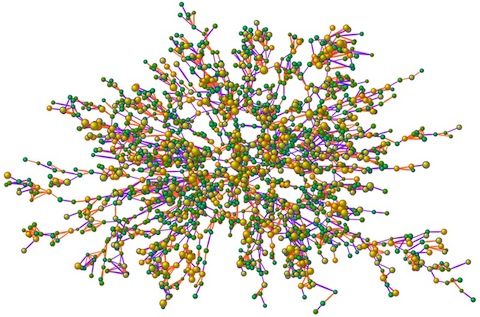
One of the issues I’ll be exploring in my next book is the notion of psychological epidemics. How do certain behaviors go viral, and how do the arcs of such epidemics mirror those of their physiological counterparts? To this point, a lot of my research has focused on incidents of mass hysteria, which are endlessly fascinating and predictably weird. My weekend reading included this 2009 paper about a day-long hysteria epidemic in Bangladesh. Like so many instances of mass hysteria, the illness arose without warning:
Approximately 25 minutes after arriving at the Jaforabad high school on saturday , August 4th, 2007, a student of 8th grade noted ‘feverishlike’ feeling in his classroom; shortly thereafter he experienced vertigo, headache, nausea, burning in body, tingling sensation in limbs and dizziness. Similar symptoms soon developed in several students in his room. As the classroom was being evacuated, more students of different grades reported symptoms, and high grades of the school became panic area. Emergency medical personnel from nearby health complex, naming hathazari, rushed to the school within half an hour. The student who first reported symptoms (index case) and two other students were transported
to the hospital by taxi, in view of other students and teachers. Classes were canceled for the high grade from 6th to tenth grade, and that day, a total 15 learners went to the Headmaster room reported symptoms they believed were associated with exposure at the school; 3 of these learners were admitted to the hospital for observation overnight. The index student was among those hospitalized, but no explanation for his symptoms was found. Over the next two days, the school was examined by the Staff of health department including Consultant of Medicine and Upazilla Health and Family Planning Officer(UHFPO), the Local Education Officer, and state officials of the Upazilla Nirbahi Ofiicer, none of whom could detect a problem.
The authorities never did determine a root cause of the brief epidemic, but they did make one critical observation: every single affected student became ill after seeing another ill student, while no one who failed to witness a victim with their own eyes was stricken. In other words, the “virus” was transmitted by what the paper’s authors term “line of sight.”
This makes me think of the work now being done by Nicholas A. Christakis, well-known for his theories regarding the transmission of obesity and other lifestyle-related ailments along social networks. I wonder now if his model might extend to conditions that have much shorter life cycles, such as hysterical illness, as well as afflictions that are exclusively psychological in nature. In other words, if I witness one of my friends fly into a rage and punch out a window, does this raise the chances that I will do likewise over the next 24 to 48 hours?


Captured Shadow // Jul 12, 2011 at 12:21 pm
The transferability of obesity is a very interesting phenomenon. Obesity as a result of overeating is also interesting to me because of people’s seeming inability to control overeating. It really puts the idea of free will into question, because what could be better under your control than what you put in your mouth.
Berton Roueche covered a mass hysteria event in either “The Medical Detectives” I think. A similar school where the illness was line of sight….
Jordan // Jul 12, 2011 at 1:48 pm
Radiolab covered an episode of mass hysteria in Tanzania and also had some follow-ups:
http://www.radiolab.org/blogs/radiolab-blog/2008/sep/11/meanwhile-back-in-tanzania/
@Captured Shadow
There are a lot of complex feedback loops in the brain that control the feeling of hunger. Plenty of opportunities for disregulation. Since excess supply of food would have been pretty uncommon when we were evolving, there wouldn’t have been much selective pressure to control the feedback loops going out of control in that fashion.
A // Jul 13, 2011 at 8:46 am
For ever every outside streams away
From off all objects, since discharge they may;
And when this outside reaches other things,
As chiefly glass, it passes through; but where
It reaches the rough rocks or stuff of wood,
There ’tis so rent that it cannot give back
An image. But when gleaming objects dense,
As chiefly mirrors, have been set before it,
Nothing of this sort happens. For it can’t
Go, as through glass, nor yet be rent- its safety,
By virtue of that smoothness, being sure.
‘Tis therefore that from them the images
Stream back to us; and howso suddenly
Thou place, at any instant, anything
Before a mirror, there an image shows;
Proving that ever from a body’s surface
Flow off thin textures and thin shapes of things.
Thus many images in little time
Are gendered; so their origin is named
Rightly a speedy. And even as the sun
Must send below, in little time, to earth
So many beams to keep all things so full
Of light incessant; thus, on grounds the same,
From things there must be borne, in many modes,
To every quarter round, upon the moment,
The many images of things; because
Unto whatever face of things we turn
The mirror, things of form and hue the same
Respond. Besides, though but a moment since
Serenest was the weather of the sky,
So fiercely sudden is it foully thick
That ye might think that round about all murk
Had parted forth from Acheron and filled
The mighty vaults of sky- so grievously,
As gathers thus the storm-clouds’ gruesome night,
Do faces of black horror hang on high-
Of which how small a part an image is
There’s none to tell or reckon out in words.
Combat in Charcoal | Microkhan by Brendan I. Koerner // Aug 11, 2011 at 9:35 am
[…] with the transmission methods for mass psychological illness, one of the main themes I’ll be exploring in my next book is how traumatized Vietnam veterans […]